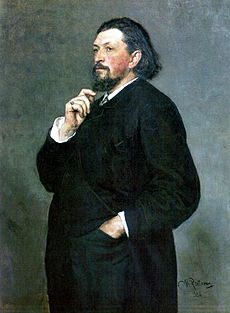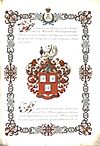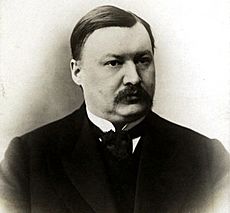Alexander Glazunov facts for kids
Quick facts for kids
Alexander Glazunov
|
|
|---|---|

Portrait of Glazunov by Ilya Repin, 1887
|
|
| Born | 10 August 1865 |
| Died | 21 March 1936 |
| Occupation |
|
| Organization | Saint Petersburg Conservatory |
|
Works
|
List of compositions |
Alexander Konstantinovich Glazunov (10 August 1865 – 21 March 1936) was a famous Russian composer, music teacher, and conductor. He lived during the late Russian Romantic period.
Glazunov was the director of the Saint Petersburg Conservatory from 1905 to 1928. He played a key role in changing the institute's name and structure after the Bolshevik Revolution. He stayed as head of the Conservatory until 1930, even though he left the Soviet Union in 1928 and never went back. One of his most famous students during this time was Dmitri Shostakovich.
Glazunov was good at blending Russian national music with a more international style. He followed in the footsteps of Russian nationalist composers like Balakirev. He also took inspiration from Borodin's grand musical style. He learned from Rimsky-Korsakov's amazing orchestra skills. He also used Tchaikovsky's beautiful melodies and Taneyev's clever contrapuntal techniques. Some younger composers, like Prokofiev and Shostakovich, later thought his music was a bit old-fashioned. However, they still respected him as an important composer. He was a steadying influence during a time of big changes in music.
Contents
Biography
Early Life and Talent
Alexander Glazunov was born in Saint Petersburg, Russia. His father was a rich publisher. Alexander started learning piano when he was nine years old. He began composing his own music at just 11.
Mily Balakirev, a leader of the nationalist group "The Five", quickly saw Glazunov's amazing talent. He showed Glazunov's work to Nikolai Rimsky-Korsakov. Rimsky-Korsakov remembered, "Balakirev once brought me the music of a fourteen- or fifteen-year-old high-school student, Alexander Glazunov. The boy's talent was clearly there." Rimsky-Korsakov taught Glazunov as a private student. He said Glazunov's musical skills grew "literally by the hour." By 1881, Rimsky-Korsakov saw Glazunov as a fellow composer, not just a student. Glazunov's first of eight symphonies was performed in 1882 when he was only 16.
Supported by Belyayev

A rich timber merchant and music lover named Mitrofan Belyayev was very impressed by Glazunov's music. Belyayev became very interested in Glazunov's future as a musician. He then extended his support to a whole group of Russian nationalist composers.
In 1884, Belyayev took Glazunov on a trip to Western Europe. Glazunov met the famous composer Liszt in Weimar, Germany. Glazunov's First Symphony was performed there. Belyayev also rented a hall and hired an orchestra to play Glazunov's music. This led to the start of the Russian Symphony Concerts in 1886.
In 1885, Belyayev opened his own music publishing company in Germany. He first published music by Glazunov and other young composers. To help choose which music to publish, Belyayev asked Glazunov, Rimsky-Korsakov, and Anatoly Lyadov to be his advisors. This group of composers became known as the Belyayev Circle.
International Recognition
Glazunov quickly became famous around the world. In the 1890s, he wrote three symphonies, two string quartets, and a ballet. When he became director of the Saint Petersburg Conservatory in 1905, he was at the peak of his creative abilities. His best works from this time include his Eighth Symphony and his Violin Concerto.
He received special honorary music degrees from Oxford and Cambridge universities. There were also concerts in Saint Petersburg and Moscow that played only his music to celebrate his 25th anniversary as a composer.
A Conductor's Life
Glazunov first conducted an orchestra in 1888. The next year, he conducted his Second Symphony in Paris at the World Exhibition. He became a conductor for the Russian Symphony Concerts in 1896.
He sometimes conducted his own music, especially the ballet Raymonda. He would joke, "You can criticize my compositions, but you can't deny that I am a good conductor and a remarkable conservatory Director."
Even during the difficult times of World War I and the Russian Civil War, Glazunov continued to conduct. He led concerts in factories, clubs, and for the Red Army. He played a big part in Russia's celebration of Beethoven's 100th death anniversary in 1927. After leaving Russia, he conducted his works in Paris in 1928. He then had engagements in many other countries, including the United States.
Leading the Conservatory
In 1899, Glazunov became a professor at the Saint Petersburg Conservatory. After the 1905 Russian Revolution, he became its director. He stayed in this role until the revolutionary events of 1917. His Piano Concerto No. 2 was first performed at the first concert held in Petrograd after that date.
After World War I, he helped reorganize the Conservatory. He worked very hard to improve the courses, raise standards for students and staff, and protect the school's reputation. He helped create an opera studio and a student orchestra.
Glazunov cared deeply for his students, especially those who needed help, like Dmitri Shostakovich and Nathan Milstein. He personally checked on hundreds of students each year.
Because of Glazunov's good reputation, the Conservatory received special status after the October Revolution. Glazunov worked well with the new government, especially with Anatoly Lunacharsky, the minister of education. However, some professors and students wanted more modern methods. Glazunov saw these demands as harmful. He took the chance to go abroad in 1928 for the Schubert celebrations in Vienna. He never returned to Russia.
Life Abroad
Glazunov traveled around Europe and the United States in 1928. He settled in Paris by 1929. He always said he stayed away from Russia because of "ill health." This allowed him to remain a respected composer in the Soviet Union. In 1929, he conducted the first full electrical recording of his ballet The Seasons. In 1934, he wrote his Saxophone Concerto. This showed he could still write new and exciting music.
Family Life
In 1929, when he was 64, Glazunov married Olga Nikolayevna Gavrilova. Olga's daughter, Elena Gavrilova, had been a soloist in the first Paris performance of his Piano Concerto No. 2. Glazunov later adopted Elena, and she became Elena Glazunova.
His Final Years
Glazunov passed away in Neuilly-sur-Seine (near Paris) at the age of 70 in 1936. In 1972, his remains were moved and reburied at the Alexander Nevsky Monastery in Leningrad.
Works and Influence
Amazing Musical Memory
Glazunov was known for his incredible musical talent from a young age. With help from his mentor and friend Rimsky-Korsakov, he finished some of Alexander Borodin's great works. The most famous of these are Borodin's Third Symphony and the opera Prince Igor, which includes the popular Polovtsian Dances. It is said that Glazunov could remember the overture to Prince Igor after hearing it played on the piano only once. However, this is hard to believe for such a complex piece of music!
Key Compositions
Today, Glazunov's most popular works are his ballets The Seasons and Raymonda. Some of his later symphonies, especially the Fourth, Fifth, and Sixth, are also well-known. His two Concert Waltzes are also popular. His Violin Concerto was a favorite of the famous violinist Jascha Heifetz. It is still played and recorded today. His last work, the Saxophone Concerto (1934), showed that he could adapt to newer music styles of his time.
Glazunov's musical journey was interesting. He was admired by nationalist composers who mostly taught themselves. These composers, except for Rimsky-Korsakov, did not trust formal music training. Glazunov's first two symphonies showed many nationalist styles used by Balakirev and Borodin. His symphonic poem Stenka Razin also used a folk song called "Song of the Volga Boatmen" and an orientalist style.
By his early 20s, Glazunov realized that the arguments between formal music training and nationalist styles were no longer important. Even though he used Russian folk music in his compositions, Glazunov's great skill allowed him to write in a very refined way. With his Third Symphony, he tried to make his music more international, like Tchaikovsky.
The Third Symphony was a turning point for him. With the Fourth Symphony, he found his mature style. This symphony was written as a work that looked to the West, but it still sounded clearly Russian. He continued to combine Russian tradition and Western techniques in his Fifth Symphony. After his Eighth Symphony, his duties at the Conservatory slowed down his composing. He started a Ninth Symphony but never finished it.
Glazunov wrote three ballets, eight symphonies, and many other orchestral pieces. He also composed five concertos (two for piano, one for violin, one for cello, and one for saxophone). He wrote seven string quartets, two piano sonatas, and other piano pieces. He also wrote some songs. He worked with the choreographer Michel Fokine to create the ballet Les Sylphides. This ballet used music by Frédéric Chopin that Glazunov arranged for orchestra.
The famous ballet producer Sergei Diaghilev thought about asking Glazunov to compose the music for his ballet The Firebird. But he eventually asked Igor Stravinsky instead.
Glazunov and Stravinsky
In his autobiography, Igor Stravinsky said that when he was young, he really admired Glazunov's perfect musical form and clear writing. At 15, Stravinsky even arranged one of Glazunov's string quartets for solo piano. He also based his own Symphony in E♭ on Glazunov's symphonies.
However, Stravinsky's opinion changed over time. He later said that Glazunov was one of the most unpleasant people he had met. After a private performance of Stravinsky's symphony, Glazunov reportedly told him, "Rather heavy instrumentation for such music."
Glazunov did not support the modern direction Stravinsky's music took. He was not alone in this view. Their shared teacher, Rimsky-Korsakov, also became very traditional by the end of his life. Glazunov was not worried about Russian music becoming too academic. He also did not share Rimsky-Korsakov's respect for new musical ideas.
Glazunov likely treated Stravinsky politely, but his opinion of Stravinsky's music was different when he spoke to others. At a performance of Feu d'artifice (Fireworks), he reportedly said, "No talent, just dissonance." (Interestingly, Sergei Diaghilev was also in the audience and was so impressed by this music that he sought out Stravinsky for the Ballets Russes.) Glazunov eventually thought Stravinsky was only good at arranging music for orchestra. In 1912, he said, "Petrushka is not music, but it is excellently and skillfully orchestrated."
In 1962, when Stravinsky visited the Soviet Union, he saw a photograph of Glazunov at the Leningrad Conservatory. Stravinsky reportedly sighed and said "Glazunov!"
Glazunov and Modern Music
Stravinsky was not the only composer whose modern music Glazunov disliked. Shostakovich mentioned Glazunov's criticisms of "recherché cacophonists." This was Glazunov's term for the newer generation of Western composers, starting with Debussy. When Franz Schreker's opera Der ferne Klang was performed in Leningrad, Glazunov called it "Horrible Music!"
However, to Glazunov's credit, even if he thought a piece of music was "cacophonic," he would still listen to it. He would keep listening to try and understand it. He "understood" Wagner's music this way. He did not understand anything about Die Walküre the first few times he heard it. But after listening to it ten times, he finally understood and liked the opera very much.
Glazunov and Shostakovich
Dmitri Shostakovich entered the Petrograd Conservatory at age 13, making him the youngest student there. He was a very hardworking student. Glazunov may have seen a bit of his younger self in Shostakovich. He closely watched Shostakovich's progress. When Shostakovich earned his doctorate, Glazunov recommended him for a higher degree.
Glazunov also arranged for the first performance of Shostakovich's First Symphony. This happened on 12 March 1926, with the Leningrad Philharmonic. This was 44 years after Glazunov's own First Symphony was first performed in the same hall. Shostakovich's symphony caused a big stir, much like Glazunov's first symphony had done years before.
|
See also
 In Spanish: Aleksandr Glazunov para niños
In Spanish: Aleksandr Glazunov para niños



